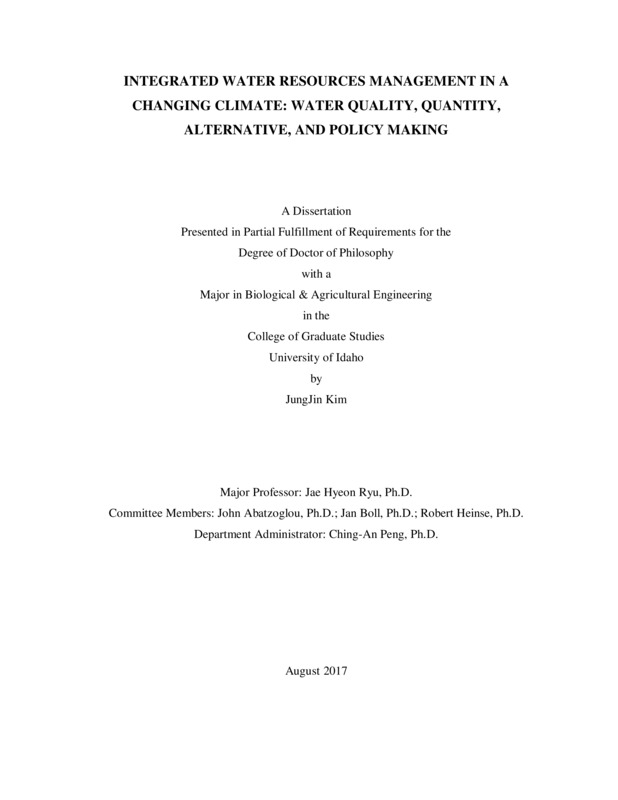INTEGRATED WATER RESOURCES MANAGEMENT IN A CHANGING CLIMATE: WATER QUALITY, QUANTITY, ALTERNATIVE, AND POLICY MAKING.
Kim, JungJin. (2017-08). INTEGRATED WATER RESOURCES MANAGEMENT IN A CHANGING CLIMATE: WATER QUALITY, QUANTITY, ALTERNATIVE, AND POLICY MAKING.. Theses and Dissertations Collection, University of Idaho Library Digital Collections. https://www.lib.uidaho.edu/digital/etd/items/kim_idaho_0089e_11082.html
- Title:
- INTEGRATED WATER RESOURCES MANAGEMENT IN A CHANGING CLIMATE: WATER QUALITY, QUANTITY, ALTERNATIVE, AND POLICY MAKING.
- Author:
- Kim, JungJin
- Date:
- 2017-08
- Keywords:
- Climate change Hydrologic model LID/BMPs Optimization Parallel computing Water resources management
- Program:
- Biological & Agricultural Engineering
- Subject Category:
- Engineering; Water resources management
- Abstract:
-
Land Use and Land Change (LULC) and climate variability are significant elements of the integrated water resources management to deal with water quality and quantity at the rural and urban interface. Adaptive strategies to develop sustainable water resources, therefore, are necessary to evaluate the water resources system in a changing global environment. In this dissertation, a series of analytical processes are implemented. First, gap filling processes are conducted by identifying a threshold of missing levels using daily precipitation series. The result indicates that about 15 % missing level of data is plausible to construct daily precipitation series for further hydrological analysis when the Gamma Distribution Function (GDF) is used as an estimation method. It is expected that such a finding can contribute to gap filling guidelines in the field, especially for water managers and hydrologists to take advantage of skillful estimates for missing daily precipitation data. Specifically, a gamma distribution function with statistical correlation (GSC) coupled with cluster analysis (CA) is used to estimate daily precipitation records and the result shows that GSC/CA outperformed other gap filling methods when rain and no-rain conditions are applied in the study area. Additionally, the dissertation identifies how Hydrological Simulation Program-Fortran (HSPF) model can improve performance depending on different sizes of watershed discretization levels within rainfall-runoff modeling settings. All simulations at different discretization levels above approximately 23% of the basin size resulted in satisfactory performances. However, the modeling performances are limited when the catchment size reaches below 8.18% of the basin size, regardless of automatic calibration efforts. The result indicates that basin discretization at finer scales does not necessarily improve HSPF simulation results with Next-Generation Radar (NEXRAD) inputs.
Computer parallelism and spatio-temporal analysis is another avenue in this dissertation in the sense that the proposed method can advance hydrological simulations using HSPF along with different calibration scenarios. Thus, the result indicates that computer parallelism could save computation time up to 90%, while simulation improvement is achieved by 81%. This finding, therefore, will provide useful insights for hydrologists to design and set up their hydrological modeling exercises in a changing climate. As part of this dissertation, the evaluation of potential changes in water quality and quantity associated hydrologic changes in response to climate and LULC changes is also investigated. For example, HSPF model based on future LULC changes associated with climate scenarios was applied to generate climate-induced streamflow and to evaluate water quality in the Boise River Watershed (BRW). The result shows that the combined impact of LULC changes and climate variability on the BRW is inevitable, but seasonal variations in streamflow and water quality are primarily noticeable. This finding may provide useful information to develop sustainable water resources management when both water quality and quantity is an issue at the snow dominated watershed in a changing climate.
Lastly, under the circumstance: increasing concerns on water quality associated with LULC changes and climate variability, identification of critical hot spots (CHSs) and the implementation of mitigation activities using low impact development (LID)/Best Management Practices (BMPs) is a critical exercise to improve water quality at the BRW. Based on preliminary environmental analysis using different methods, load per sub-area index (LPSAI) is selected as the most cost-effective method because it can reduce the average pollutant loads at the watershed outlet while minimizing cost.
- Description:
- doctoral, Ph.D., Biological & Agricultural Engineering -- University of Idaho - College of Graduate Studies, 2017-08
- Major Professor:
- Ryu, Jae Hyeon
- Committee:
- Abatzoglou, John T.; Boll, Jan; Heinse, Robert
- Defense Date:
- 2017-08
- Identifier:
- Kim_idaho_0089E_11082
- Type:
- Text
- Format Original:
- Format:
- application/pdf
- Rights:
- In Copyright - Educational Use Permitted. For more information, please contact University of Idaho Library Special Collections and Archives Department at libspec@uidaho.edu.
- Standardized Rights:
- http://rightsstatements.org/vocab/InC-EDU/1.0/

